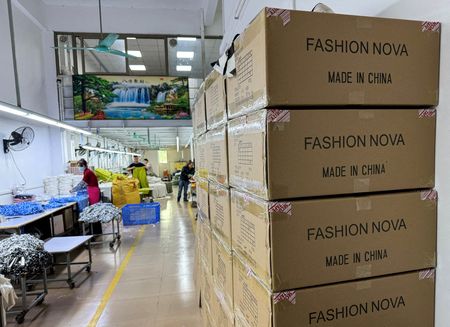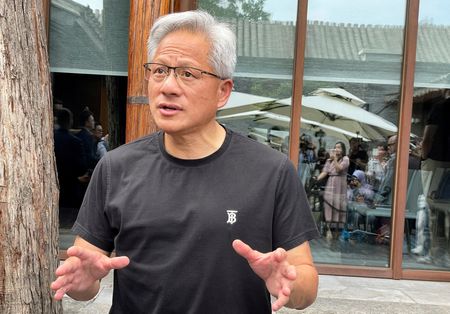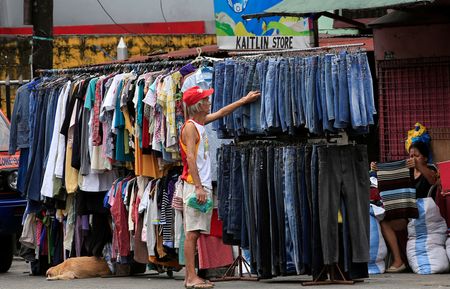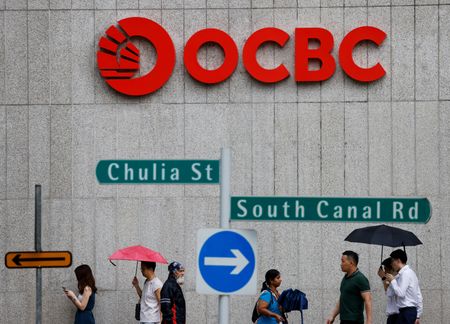By Joe Cash and Ethan Wang
BEIJING (Reuters) -Chinese exports unexpectedly fell in October after months of front-loading U.S. orders to beat President Donald Trump’s tariffs, in a stark reminder of the manufacturing juggernaut’s reliance on American consumers even as it woos buyers elsewhere.
The world’s second-largest has pushed hard to diversify its export markets since Trump won last November’s presidential election, bracing for a resumption of the trade war that dominated his first term in office, and seeking closer trade ties with Southeast Asia and the European Union.
But no other country comes close to matching China’s sales of more than $400 billion in goods to the U.S. each year, a loss that economists estimate has cut China’s export growth by around 2 percentage points, or roughly 0.3% of GDP.
The October customs data on Friday underlined that point, as China’s outbound shipments shrank 1.1%, the worst performance since February, reversing from an 8.3% rise in September, and missing a forecast for 3.0% growth in a Reuters poll.
“Last month’s weakness was driven by a broad-based slowdown in shipments to non-U.S. markets,” said Zichun Huang, China economist at Capital Economics, adding that while shipments to the U.S. fell sharply, a rise in exports to transit hubs such as Vietnam suggested producers were still trying to beat the duties and move inventory to the U.S.
To be sure, the latest figure was affected by a high base from last October when exports grew at their fastest pace in over two years, as factories began rushing inventory to major markets in anticipation of Trump making a comeback to the White House.
However, most analysts largely agreed Chinese manufacturers had pushed as many goods into the world as possible for now.
“Exports through Vietnam to the U.S. will decelerate once the frontloading is over, and we’re there. So I think its going to be much tougher for China in the fourth quarter, which means its going to be tougher in the first half of 2026 as well,” said Alicia Garcia-Herrero, chief economist for the Asia-Pacific at Natixis.
Chinese exports to the U.S. tumbled 25.17% year-on-year, the data showed, while those to the European Union and Southeast Asian economies – big trading partners with whom policymakers have sought to bolster ties amid tariff tensions with Washington – grew by just 0.9% and 11.0%, respectively.
“I think the PMI was already warning us that Chinese exports cannot continue to grow forever, and its not only because of the U.S. but because the global economy is slowing,” Garcia-Herrero said.
The official purchasing managers’ index fell to a six-month low, with factory owners reporting a marked drop in new export orders.
Woei Chen Ho, economist at UOB Singapore, said the U.S.-China trade truce struck by the two leaders earlier this month would stabilise the outlook in the near-term, but forecast that “both countries will try to reduce their interdependence and we’re going to see the U.S. share of China trade, especially exports, drop.”
Tensions between China and the U.S. unexpectedly spiked in early October, after Trump threatened 100% levies on Chinese goods in response to Beijing dramatically expanding its export controls on rare earth metals.
The mood eased after Trump met with Chinese President Xi Jinping last week in South Korea, when both sides agreed to extend their trade truce – previously scheduled to expire on November 10 – for another year.
Still, U.S.-bound Chinese goods will face an average tariff rate around 45%, above the 35% level that some economists say wipes out Chinese manufacturers’ profit margins.
China’s trade surplus came in at $90.07 billion in October, from $90.45 billion a month prior, and missing a forecast of $95.6 billion.
WEAK DOMESTIC DEMAND
Insufficient domestic demand remains a hurdle, however.
That was underlined by the data on imports, which expanded at their slowest pace in five months, up 1.0% compared to 7.4% growth in September and a 3.2% forecast rise.
Officials said last month China will aim to raise the percentage of household consumption of GDP “significantly” over the next five years, after a key conclave of the ruling Communist Party’s Central Committee mapped out economic and policy goals for 2026-2030.
“Now that export momentum has weakened, China may need to rely more on domestic demand,” said Zhang Zhiwei, chief economist at Baoyin Capital Management. “Fiscal policy is expected to be more aggressive in the first quarter of 2026.”
China’s imports of soybeans, crude oil, and iron ore rose in October from a year earlier, with record soybean purchases from South America attributed to crushers rushing to buy before potential price spikes in Brazil caused by missed China–U.S. shipments, while energy imports were supported by competitive prices.
But copper purchases, key to the construction sector, dropped as consumers shied away from restocking due to high prices for the metal and as a prolonged property downturn continues to crimp demand.
($1 = 7.1230 Chinese yuan)
(Reporting by Joe Cash and Ethan Wang in Beijing, Tom Westbrook in Singapore ; Editing by Shri Navaratnam)











